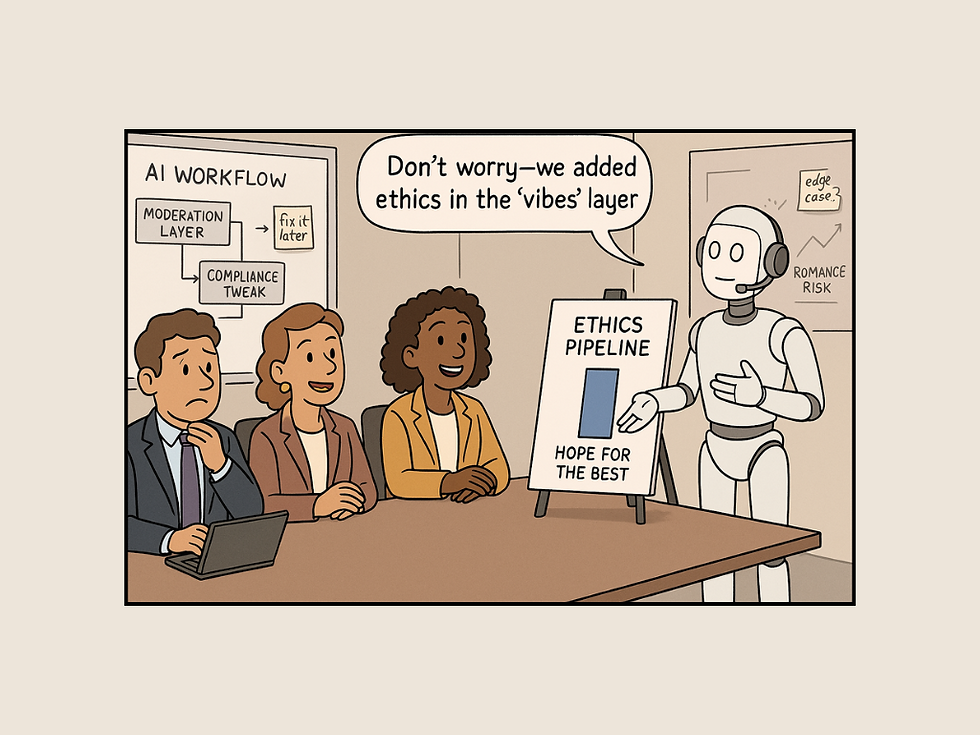Boardroom AI Governance That Actually Ships
- Jamie Bykov-Brett

- Sep 11
- 4 min read

Why this matters to me (and should to you)
I’ve spent the last few years turning AI and XR into real upskilling tools - often in mission-driven organisations where the stakes are human, not just financial. The pattern is always the same: the board wants impact without nasty surprises; the teams want clarity without red tape. When governance works, you get both. When it doesn’t, you get “policy theatre” and stalled pilots.
This article distils what I’ve seen work - from framing the right conversations to operationalising guardrails - so your board can lead decisively without slowing the business to a crawl.
Governance is not a brake. It’s traction.
Most AI “governance” reads like a list of things you can’t do. That’s a missed opportunity. Good governance is an enablement system: it accelerates the right work and constrains the wrong work. Think of it as product management for decision-making - shipping value, safely, on purpose.
Four failure patterns I keep seeing
Agenda drift: AI appears as a one-off board topic, then vanishes. No continuity, no momentum.
Shadow pilots: teams experiment in the dark; leaders discover them when something breaks.
Policy theatre: beautifully worded principles, zero operational bite.
Measurement myopia: cost savings tracked; trust, inclusion and experience ignored - until they bite back.
The Three Lines of Sight
When I build AI/XR tools with clients, the boards that get results hold these lines of sight at once:
Strategy: Does this AI use-case move a top-three business goal? If not, why are we doing it?
Workflow: Where, precisely, does the model touch a process - and what changes downstream?
People: Who gains or loses agency? What skills, inclusion and trust dynamics are in play?
Ethics, trust, cultural inclusion and measurable impact sit across all three. If any line goes fuzzy, risk rises and value leaks.
Seven moves to build governance that works (and lasts)
Make literacy a verb: Replace AI keynotes with hands-on governance. One hour a month, board and execs use the tools (yes, personally), critique outputs, and surface issues together. Curiosity isn’t a nice-to-have - it’s operational risk management.
Upgrade your competency matrix: You don’t need a board full of data scientists. You do need plural perspectives - product, risk, behavioural psychology, and change. Add “AI-cognate” experience to succession plans so oversight doesn’t hinge on one champion.
Map your system before you audit it: Instead of hunting “shadow AI,” draw a living system map: data sources, models, prompts, human checkpoints, third parties. Then audit reality against the map. In one client, this simple map surfaced a silent dependency that would’ve slowed procurement by three months.
Codify decision rights: “Who decides?” is the most underrated governance question. Create a decision rights grid for AI:
Approve (ethics/risk),
Allocate (budget/people),
Adapt (change guardrails),
Abort (kill switch). Put names, not roles, next to each. Ambiguity is a magnet for delay.
Turn principles into controls: Principles are direction. Controls are traction. Embed guardrails where work happens: templates, prompts, model access tiers, data retention defaults, vendor clauses. If a policy lives only in a PDF, it’s theatre.
Measure what money misses: I use a simple scorecard I call QUIP:
Quality (accuracy, error rates, rework),
User/employee experience (adoption, satisfaction, time-to-competence),
Inclusion & integrity (bias checks, diverse user outcomes, audit logs),
Profit & Loss impact (savings, revenue, risk cost avoided). When we added the “U” and “I” to a client’s dashboard, adoption flipped from polite resistance to active pull.
Set a cadence you can keep Governance fails when it’s episodic. Stand up a monthly AI review (operations), a quarterly risk & ethics check-in (board committee), and an annual strategy reset (full board) with explicit “start/stop/scale” decisions.
What changes when you lead this way
When boards govern for traction, three things happen fast:
Fewer zombie pilots. Clear decision rights and QUIP metrics make it obvious what to scale or stop.
Faster learning loops. Literacy sessions surface blind spots early - before they become PR or legal issues.
More trust. People feel the guardrails working for them, not against them. That’s culture change.
A 30/60/90 board starter plan
Days 1–30: Clarity
Run a live literacy session (board + execs).
Approve the system map + decision rights grid.
Identify the top five AI use-cases tied to strategy.
Days 31–60: Controls
Convert principles into embedded controls (templates, access tiers, vendor clauses).
Stand up the QUIP scorecard.
Kill or pause anything that can’t be mapped or measured.
Days 61–90: Cadence
Launch the monthly AI review and quarterly risk & ethics check-in.
Publish a one-page “AI Way We Work” for employees.
Green-light 1–2 scale - worthy bets with explicit guardrails.
For boards who want momentum, not noise
If you’re serious about leading your organisation into the AI era, start small but start in the work - where models, people and processes meet. That’s where trust is built and value is created.
Executive prompts to take into your next meeting
Which AI use-case moves a top-three business goal this quarter?
Where are our controls embedded in the workflow - not just in documents?
What would we stop doing today if QUIP made the decision obvious?
This is the work I love: blending leadership psychology with deep tech to help senior teams ship AI responsibly and at pace. If you want a structured push, my programmes are built for this - from an Executive Insights briefing to the Strategic Momentum Workshop, the Transformation Masterclass, and ongoing Coaching & Micro-Labs.
Relationship-first beats transaction-first-always.
.png)



Comments